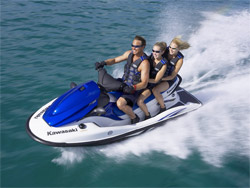
Personal Water Crafts, PWC, or jet skis, have become increasingly popular over the last decade. In fact, the jet ski now accounts for a third of new boat sales.
Did you know?There are one million jet skis in the worldwide waters today!
But many people do not consider their jet ski to be a powerful watercraft, and treat it more like a toy. Of course you should have fun on your jet ski – that’s the whole point! But there are a few things you should also consider.
Understanding your jet ski and knowing how it works is important. Here is our guide to help if you’re new to boating or if you’re thinking buying a personal water craft.
Modern technology
The jet ski was originally designed for one person. For use at high speeds with easy manoeuvrability, these stand-up models had very few features. However, recent models on the market can fit up to four people, and are even able to pull a water skier. On top of this, there is ample storage available and a high-tech dashboard.
How does it work?
Jet skis have two-cycle inboard petrol engines. Water is taken in through the bottom of the ski, and then drawn into a propeller. This creates a jet of high pressure water which pumps out through the back.
As your jet ski sucks in water for power, steer clear of water less than two feet deep. Dirt will clog the propeller which could cause damage
Be safe
You’ll find that most jet skis will not have running lights. This is because your jet ski should only be used during the day. It’s highly dangerous to use your jet ski at night, and in some countries it is illegal.
To keep you safe, personal floatation devices should be worn at all times. An adult should be onboard when a child is using the jet ski. For your added safety, a boating safety course should be undertaken before having full use of a jet ski.
The main cause of accidents is hitting another object. Always be aware of what is around you, and if you’re in a busy area, slow down before making sudden movements.
The modern jet ski is fast!They are designed to be moved easily and pick up speed very quickly. The best way to avoid a collision is to apply throttle and steer away. Don’t slow down!
You’ll find that you’ll make a whole bunch of new friends, along with your investment!When lending your jet ski to others, ensure they know the safety rules
Falling off
Most jet skis have an automatic cut-off lanyard. This is attached to your wrist or life jacket to prevent your jet ski from flying off if you fall.
If you do fall, don’t abandon the vessel. Your jet ski can be turned the right way (refer to your user manual for direction). To get back onboard, approach the back of the ski, pull yourself into a kneeling position and then take your seat. This can be quite difficult, especially in bumpy waters. You’re also likely to be tired and weak, so it’s probably best to practice in calm water first. And remember to reattach your lanyard!
Use your common sense, consider others on the water and if on doubt … slow down. But most importantly, have fun out there!